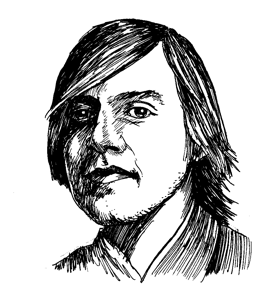Inserted into this issue is an exclusive 7-inch record adorned with art by Marcel Dzama. It serves as the soundtrack to Dzama’s film, Une danse des bouffons, which features music from, among other musicians, Dzama and Will Butler of Arcade Fire. Butler and Dzama sat down to talk about the record, the film—which will be at the David Zwirner Gallery this September—and playing in cover bands.
WILL BUTLER: Where did you get the music for Une danse des bouffons?
MARCEL DZAMA: This lovely group of my friends happened to be musicians, and I asked them if they would be interested in doing a soundtrack, and, very luckily, they were. And you are one of them. So thank you for that.
WB: You seem to work a lot with ballerinas.
MD: I was finding that living in New York, I was drawing more claustrophobic things, and I wanted to put some order to it, and making it a large dance performance kind of put order to the chaos of all these characters. So after that I started to look at ballet as actually an influence. Before that, I didn’t know anything about dance.
WB: And now the dancers have taken on a life of their own. You’ve also done a few films that are dance-based.
MD: In the 1990s I used to make these short films that were puppet-related. I never had real actors, so I just made costumes. Once I moved to New York in 2007, I was asked to do a music video for this band, Department of Eagles. That’s how it all started.
WB: Back in high school, you played in bands while you were making art. How separate are those worlds in your brain?
MD: They definitely interacted with each other. My high-school bands were mostly cover bands with a few original songs. In college it was original songs. I would make these cassette tapes and sell them on consignment and in record stores. There was this brand of chips called Old Dutch, which my family ate a lot of, and I used to turn the box inside out and draw on the box the name of the band and do a drawing on it, and put a cassette of new songs in, and then have a baggie full of weird photos that I had taken and mutilated Star Wars toys. So you’d have this surprise box that you’d get with the music.
WB: My brother, Win, started the Arcade Fire. I was in some of the proto–Arcade Fire bands when he was in college. I was basically a sideman. I wasn’t super into rock-and-roll music until late in high school, when...
You have reached your article limit
Sign up for a digital subscription and continue reading all new issues, plus our entire archives, for just $1.50/month.
Already a subscriber? Sign in





